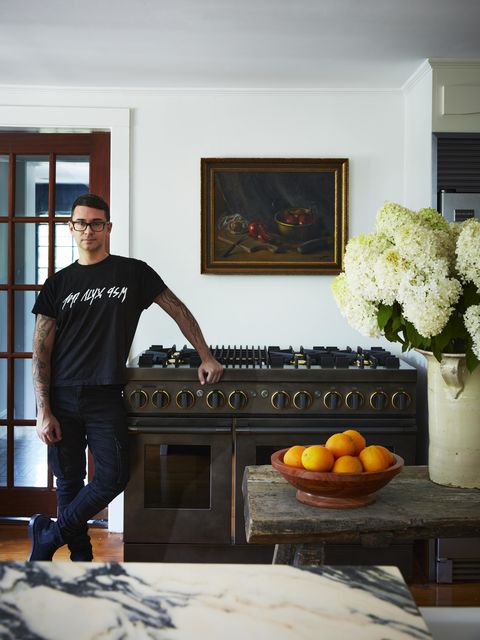Maximalism or minimalism? Traditional or modern? The dilemma of choosing one or the other has haunted the aesthetically driven for millennia. But, in the case of Christian Siriano’s newest home in Easton, Connecticut the question simply turns into: why not have both?
If one were to head 10 miles northeast from the designer’s modernist home in Westport, Connecticut to his new home in Easton, they’d notice a stark difference. Sharp lines in his Westport home are replaced with colonial architecture in his Easton one. Massive glass walls are swapped for small paned windows. Instead of a towering door to welcome his friends—including many celebrities—and family into his home, an original red craftsman’s door takes on the responsibility.
“I really bought this house with my mom in mind,” Siriano tells Town & Country. “A lot of Connecticut homes are such overwhelming estates, and this felt more warm. The previous owners lived there for over 30 years. There’s a fireplace in every room. It sits on three acres and feels very private.”
The estate was not necessarily grand or impressive when it was built in 1744. Instead, it was used as a quaint inn. “It’s literally one of the oldest houses in Connecticut which makes it so cool,” Siriano says. “The previous owners found old records of people who stayed there during the time. George Washington stayed there twice.” Though Siriano expanded the home by adding a few additional rooms, he was adamant about not making it feel like a mega-mansion. “I wanted a place for my family to come and stay in. It’s a much more cozy space, and quite old; a quintessential Connecticut home that also feels very nostalgic.”
While lovely in concept, Siriano’s desire to refresh the house while preserving its rich Americana history proved to be the most challenging part of the process. “I didn’t want to get rid of its integrity and felt that it was best to keep as many original elements that I could.”
Make no mistake, changes were definitely made. A drafty front door required a bit of attention and tearing down a few walls to open up choppy floor layouts had to be done. But many of the original features still remain. “Some spaces certainly needed more ‘beautifying’ than others. But, the original floors are still here, the doors, even the fireplaces still go up through the walls and chimney. Call it a little bit haunted, but that’s okay,” he jokes.
To please himself—and OK, maybe the ghosts—Siriano’s interior design strategy honors both past and present. One won’t find mid-century modern pieces, such as the currently trending Bellini couch, nor anything by Noguchi or Eames. Instead, a vintage Louis XVI giltwood upholstered fauteuil delicately sits in one home’s sitting rooms alongside a 1920s Georgian wingback lounge velvet chair. Anyone fancy reading a book near a fire? Perhaps the Ralph Lauren wingback chair will do. Feeling melodramatic? Writing a letter while peering out into the Connecticut fields on a 1940s writing desk will fix that. While the pieces came from a variety of sources, one city proved to be the treasure trove perfect for the project: Paris.
“Paris is my favorite place to get antiques and art. It has such a range: inexpensive, expensive. There are a ton of furniture pieces that are accessible in price, but some pieces that are not so accessible,” he says.
But, perhaps the most impressive thing about the house is the art within it. Earlier this year, the late Anne Bass’ collection sold at Christie’s auction house, generating $363 million. Aside from her collection boasting names like Degas, Monet, and Rothko, what’s most alluring about the collection is that it was a lighthouse of both tradition and modernity. The art in Siriano’s home attempts to do the same.
A portrait painting of a young man dressed in blue is placed adjacent from a contemporary abstract painting by Meighan Morrsion. A Siegal abstract expressionist painting brightens up a corner, while a still life of a water jug adorns the kitchen. “I love the mix of art like that because it reminds me of how I grew up,” Siriano says. “I love the portrait-style paintings because it fits the era of the Easton home. I try to make sure that each piece shares the same tones and colors so that when I put them together, it makes sense.”
According to him, mixing and matching is not only a philosophy for art or interior design. “I think everyone should curate their homes like their closets and vice versa,” he says. “You have your vintage jeans that you love and cool band t-shirts, but then you have your new Dior bag or fabulous Siriano Dress!”
Not straying too far from the classic American essence of the home, the first social event at Siriano’s historic Easton house took place on July 4 of this past summer. “I figured, why not have a Fourth of July slash pride party at this old Connecticut house? It probably has never seen so many gay people at once!” he jokes. “They all had their opinions of the house like which room is their favorite, of course.”
While Siriano’s illustrious group of friends pick and choose which room is their favorite, could it be that Siriano has a favorite between his Connecticut homes? “My Westport home is very open and airy, but sometimes I’ll head to the Easton home to do something cozy, like watch T.V. They’re two totally different types of houses. I even made a special nook in the Westport house to try and make it feel cozier,” he explains. “I mean, since my family will be there, I won’t be able to live in the Easton home, anyway.”
Style News Editor
Style News Editor at Town and Country covering society, style, art, and design.
link






